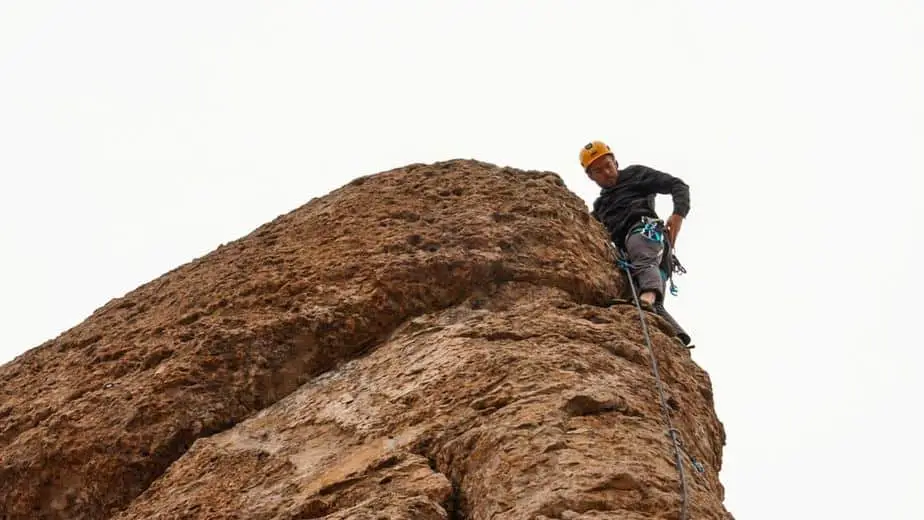The question of gear strength and condition is always lurking in a climber’s mind. We do our best to be redundant, but sometimes all that’s holding us to the wall is a single carabiner. It’s important to understand the forces at work and to be sure that it’ll catch you.
Carabiners are rated for force, not weight, so the answer comes in kiloNewtons (kN) and is marked on the side of a carabiner. Carabiners rated for climbing need to hold at least 20kN of force, which is about 4,500 lbs (2,000 kg).
We always want to know how much weight gear can hold because the measurement of force is harder to understand. We understand how weights work, and have a good frame of reference. Most of us would have no idea what 5kN means without looking it up!
Carabiner Strength Requirements
Carabiners (karabiners) need to be strong enough to not only lift and hold a human, but also strong enough to catch the force of a human falling the length of a climbing rope down to the ground in a dynamic environment. They need to be able to do this repeatedly, and do it over time as they slowly wear out.
Here’s a brief explanation of weight versus force in case you don’t remember it from high school physics. If you already know (or don’t care), skip down to the next section for an explanation of minimum requirements for climbing carabiners.
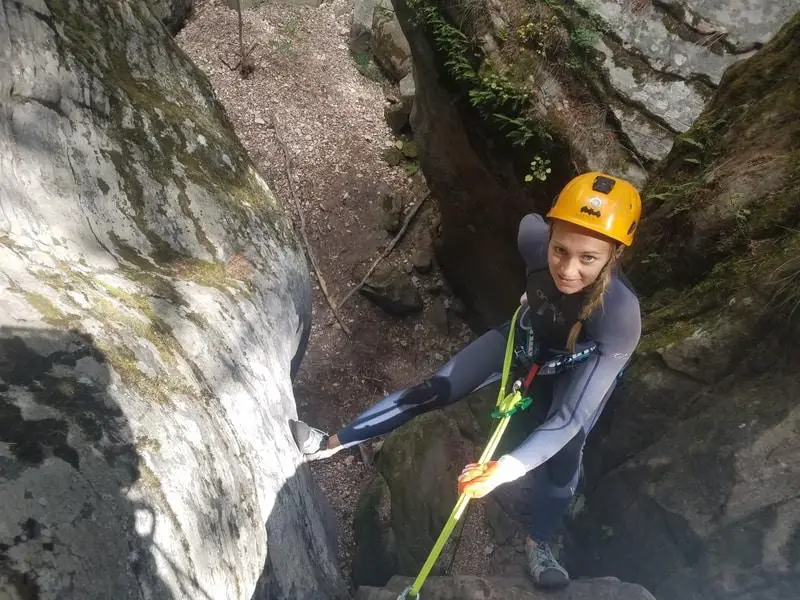
Weight Versus Force
The physics equation of Force=mass*gravity yields the actual strength requirements for a carabiner catching a lead fall. The strength required to catch a falling climber is around ten times the weight of the climber due to the acceleration due to gravity of 9.8 m/s2. However; even with the gravity factor included, climbing gear is rated well above what climbers really need.
This is where we come up with the conversion of 20kN to 4500 pounds. 20kN, or 20,000 N divided by the force of gravity (9.8 m/s2) equals 2,040kg. Multiply that by 2.2 to get the weight in pounds (~4500 lbs).
Just because a carabiner can lift a car though doesn’t mean you should try it- they aren’t just used to lift static loads. They also need to be able to keep their integrity during the most extreme dynamic whippers. Based on the conversion of force to weight, a carabiner can lift a car.
The problem comes if you shock-load the carabiner by pushing the car off of a cliff and try to catch it with a rope and carabiner (theoretical of course, unless someone has an old car and a cliff we could experiment with?). Obviously in this situation, the rope or carabiner would snap.
Age Factor of Climbing Gear
It’s important to realize that the ratings shown on climbing gear are the strength factors the gear has when brand new. Climbing gear, slings and ropes especially, wears out over time. In a quickdraw, the carabiners are actually the ‘weak link’ initially, but the slings wear out more quickly over time.
Aluminum and steel carabiners will pretty much last forever if they aren’t used. They don’t really wear out over time just by sitting there. They do wear out with use though, which is easy to distinguish on colored carabiners.
Older, well-used carabiners can develop ridges or spurs that can potentially damage a rope. Additionally, the gates usually aren’t as quick and responsive as they were when they were new, which means you are more likely to accidentally not close the gate or nose-clip it.
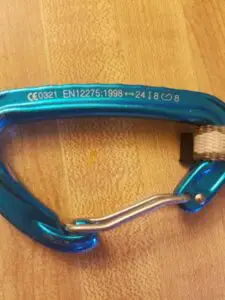
Carabiner UIAA Minimum Strength Requirements
The UIAA is an international body that ensures certain minimum standards are met for climbing and mountaineering equipment. They do two things- first, they determine the minimum requirements that gear needs to meet in order to be safe.
Second, they test gear in their labs and certify the gear that passes. The other main certifying body for climbing equipment is CE, which is the required certification in Europe. Some gear has both certifications, but the requirements are virtually the same.
For example, a company like Black Diamond or Petzl will approach the UIAA and/or CE with a new carabiner, and ask them to certify that it meets the stringent safety requirements necessary for rock climbing.
The certifying organization will test a certain number of these carabiners and, if they pass, allow the manufacturer to etch “UIAA” or “CE” on the side of the carabiner. This helps climbers to trust that a third party tested the gear and found it to be safe.
The UIAA’s strength requirements for carabiners depend slightly on the shape of the carabiners- some need to be stronger than others because of inherent weaknesses in the shapes as well as the intended uses.
Basic Carabiners
- Main Direction (Major Axis)- 20kN
- Transverse Direction (Minor Axis)- 7kN
- Gate Open- 7kN
Directional Carabiners (Quickdraws)
- Main Direction (Major Axis)- 20kN
- Transverse Direction (Minor Axis)- N/A
- Gate Open- 7kN
HMS Carabiners (belaying)
- Main Direction (Major Axis)- 20kN
- Transverse Direction (Minor Axis)- 7kN
- Gate Open- 6kN
Oval Carabiners
- Main Direction (Major Axis)- 18kN
- Transverse Direction (Minor Axis)- 7kN
- Gate Open- 5kN
Quick Links (Maillon Rapides)
- Main Direction (Major Axis)- 25kN
- Transverse Direction (Minor Axis)- 10kN
- Gate Open- N/A
Klettersteig (Via Ferrata)
- Main Direction (Major Axis)- 25kN
- Transverse Direction (Minor Axis)- 7kN
- Gate Open- N/A
You can view the UIAA’s full safety standards here on its website .
.
Different kinds of carabiners have slightly different strength requirements, as do the different orientations of the carabiners. In a perfect world, you’ll always fall and apply force along the major axis of the carabiner.
This is how they’re intended to be used, and many modern belay carabiners try to guarantee this. As shown above, carabiners are 3-4 times stronger along the major axis than along the minor axis or even with the gate open.
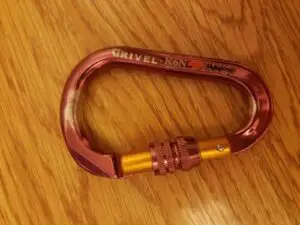
Get in the habit of keeping your carabiners aligned so that they don’t cross load. Cross-loading is when the force is applied across the minor axis instead of the major axis. It should still hold you, but there have been a few accidents because of cross-loading so it’s best to rotate the carabiners until the force is applied the right way.
Carabiner-Related Climbing Accidents
Climbing accidents are rare, but they do happen. Most of the time they are caused by human error- tying a knot wrong, a belayer not paying attention or freezing up, or mistakes on the rappel. Occasionally accidents happen due to gear. Here are some examples of how carabiners can…let you down.
- Nose-Clipping a Quickdraw- This happens when a climber hooks the nose of the carabiner on a bolt instead of going all the way through. The nose of a carabiner really can only handle a force of about 2kN, so climbers need to always make sure the carabiner clips shut.
- Forget to Lock the Carabiner- Screwgate carabiners need to be spun shut every time. Otherwise they can inadvertently come open when anything pushes against the gate. Auto-locking carabiners
 help to avoid this problem.
help to avoid this problem. - Gate Stays Open- Sometimes the gate gets caught on something like the rope or your harness and fails to clip shut. This is especially likely with an auto-locking carabiner because you probably aren’t as much in the habit of checking to make sure it’s closed.
- Cross-Loading a Carabiner- Applying a lot of force to the gate can make it pop the little pin and break. Carabiners are designed for forces pulling outwards, not pushing from the gate inwards.
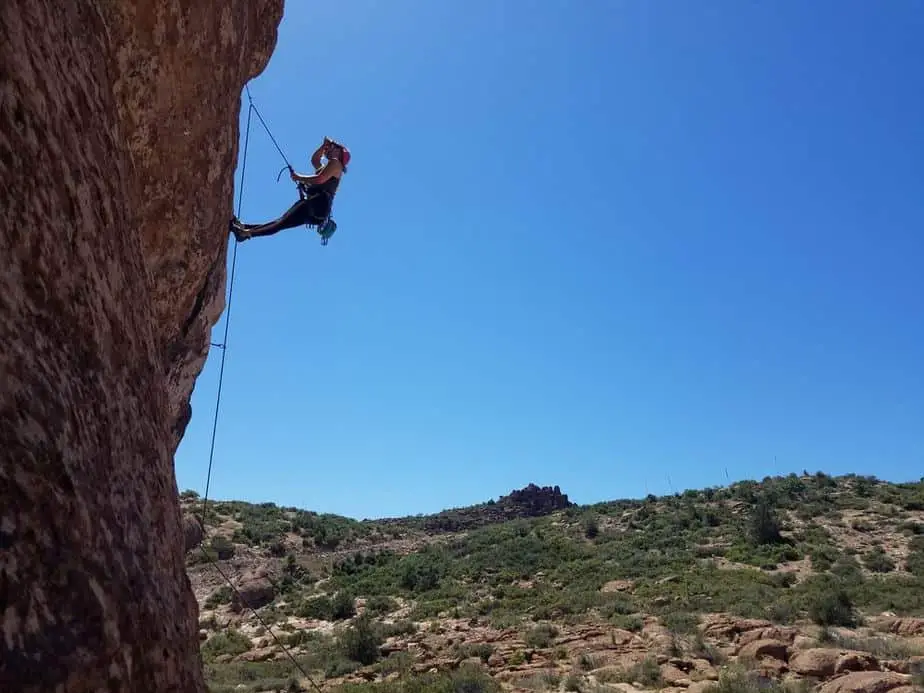
How Much Force Can Climbing Exert On Gear?
There’s a big difference between the strength of the carabiner in the correct orientation (20kN+) and across the minor axis (7kN+). If you calculate it, 7kN is about 1,573 pounds (~700kg). You don’t weight this much, but can you generate that much force if you take a really long fall?
The UIAA has done a lot of testing of the forces generated by a lead fall both in their labs as well as in the wild, and have found that the max amount of force a fall can generate on gear is 5kN.
Petzl has done something similar, and found that they could get up to 6kN of force on the anchors. This is awfully close to the minimum strength requirements with an open gate or on the minor axis, but it’s pretty hard to take a fall that severe when you’re climbing.
Are Stronger Carabiners Worth It?
Climbing carabiners usually advertise a strength rating of between 20 and 30 kilo-Newtons. It can be tempting to always go for the ‘stronger’ carabiner, but it’s not always the best choice. First of all, 20kN is PLENTY strong enough to catch you in any fall you can generate.
Additionally, ‘stronger’ carabiners are usually heavier. If you’re deciding between two carabiners and everything else is equal, sure, go ahead and buy the stronger one.
Untested Counterfeit Climbing Gear
The growth and popularity of climbing, as well as the perceived high prices for high-quality climbing gear, have lead to low-cost competitors entering the market. It’s not easy to get a carabiner to be strong enough to handle the rigors of climbing, and there is some cost involved in getting gear certified.
Most carabiners that aren’t rated for climbing are marked “NOT FOR CLIMBING” somewhere along this spine. This is to ensure they don’t get sued if you misuse it. Other manufacturers are trying to sell gear to climbers that hasn’t been properly tested and certified. This can be extremely dangerous, and has caused accidents in the field.
Some counterfeit gear manufacturers have recently gone as far as to mark CE on their gear in a different font, supposedly standing for “China Export” (even though it looks a lot like the certified gear logo).
The best way to avoid buying counterfeit gear is to buy gear from real climbing brands. If they’re willing to put their name on it, you can bet that it’s been through enough testing to keep them out of a lawsuit!
Summary
Carabiners can lift a car, and can catch a falling climber. They are extremely strong, but work best when the force is applied along the major axis. Tests have found that the maximum force a falling climbing can apply to an anchor is 5-6kN.
In order to get the UIAA certification, carabiners have to meet certain strength requirements, as listed above. Always buy gear that has been certified by the UIAA and/or CE to ensure that it is strong enough to keep you safe.
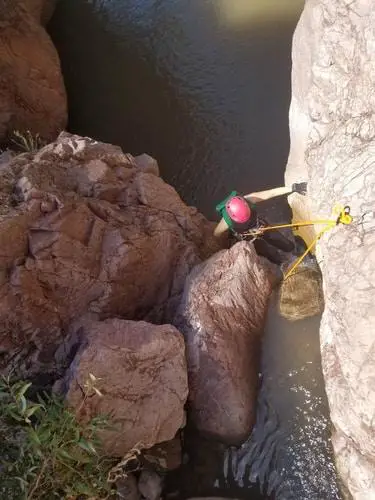
Sources:
Related Questions
How Many Pounds Can a Carabiner Hold? Carabiners that are certified for climbing need to be able to hold at least 20kN of force along the major axis. The exact strength is marked along the spine. A 20kN-rated carabiner can hold about 4,500 pounds statically.
How Much Weight Can a 30kN Carabiner Hold? A 30kN carabiner can hold 6,744 pounds (3,000kg). This weight is the static maximum, not the dynamic maximum. A carabiner could lift that much weight, but could not catch that much weight if it fell.
How Strong Is A Carabiner? Carabiners are rated by force, not by weight. The strength of a carabiner is usually stamped or etched onto the carabiner’s spine. Carabiners for climbing need to meet strength requirements as determined by the UIAA, 20kN or greater along the major axis.

